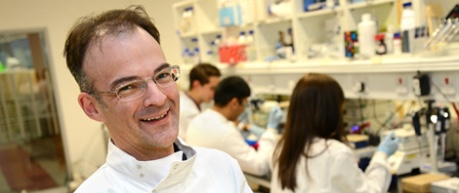Friday 15th April 2016, 1:00pm
Writing in PLoS Pathogens, Professor Neil Mabbott highlights the continued need to study prion diseases.
In the article series Research Matters, scientists offer a personal perspective of the impact of their work on public health, human knowledge and life. In the latest article by Neil Mabbott, a group leader at The Roslin Institute, he describes the public’s interest in his work on prions following the statement by the UK’s Secretary of State in 1996 about the likely link between bovine spongiform encephalopathy (BSE) and the human prion disease variant Creutzfeldt Jakob disease (vCJD).
Prion diseases are still untreatable, but basic research over the past decade has provided important insights into how prion proteins can be transmitted and has enabled the adoption of measures, such as the removal of white blood cells from blood for transfusion, to reduce the potential of disease transmission in humans.here is a clear need for further research into how prions spread from the gut to the brain and cause irreversible damage, particularly in young people, and for the translation of such knowledge into therapies.

Neil Mabbott’s work suggests that prions hijack a subset of immune cells in the small intestine to spread throughout the body to the brain and that the effects of ageing on the immune system could reduce disease susceptibility.
Although the incidence of prion diseases in humans is rare, the continued emergence in animals (see recent reports of chronic wasting disease in deer and elk in US and EU) and risk to the food chain warrants prion diseases remaining a national research priority.
The Neurobiology Division at The Roslin Institute has made significant contributions to this field, and with its unique inbred Cheviot sheep flock with endemic scrapie and atypical scrapie, as well as valuable rodent models of neurodegeneration, will continue to advance our understanding of these diseases.